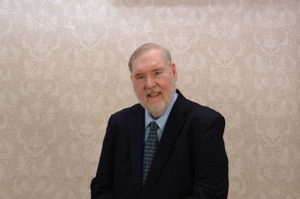Author photos…
I probably don’t do enough of them because I haven’t found one I really like yet. Although my headshots appear in many places on the internet and in my books, they all look staged. Just below is my most recent one, which seems very staged (first pro shot). One of my first, with sunglasses, makes me look a bit like Tom Clancy. With my glasses off, my kids used to say I looked like Kris Kristofferson.

I think authors have a tough time with photos because a lot of us are nerdy introverts and not eager to project a public image in the photographs or otherwise. I still think a real headshot is better than some iconic doll or flowers, though. People sometimes want to know more about the authors they’re reading, the face behind the words as it were.
I just finished upgrading and updating my website, more to get some new book covers in, but that recent headshot is there too. (The job was done by Monkey C Media, my website gurus—thanks to them, the old website hangs in there.) That photo might put fear into a young adult reader interested in A.B. Carolan’s books, but hopefully they will learn I don’t write horror stories (and neither does A.B., and he doesn’t have a headshot—his icon in some places is a leprechaun, which suits him just fine).
An author’s promotional efforts bifurcate into two marketing areas: (1) personal branding, and (2) promoting her or his books. Fiction authors often forget #1 and focus on #2. #1 is an obvious goal for “experts” in something who write about it—the personal brand is what markets their non-fiction book(s)—so they worry about it. Even some fiction writers are better known for their personal brands—their fiction becomes an afterthought after they start making more money giving advice to other authors like “Just do what I say in my marketing books, and you’ll become a NY Times bestselling author.”
Unfortunately most fiction authors have to deal with both #1 and #2. I’m new to Twitter, but from the very beginning I didn’t want to spam the Twitterverse with ads for my books. I try to let readers and the #writingcommunity know who I am with pithy comments, retweets, and so forth; hopefully some of them help authors too. I also poke a wee bit of fun at the publishing business with my #daffynitions and try to motivate everyone with quotes from famous authors that I particularly like. I also “like” similar things other authors post but rarely their book ads (I read most of them, though, if that makes them feel any better).
Facebook and Twitter are media that help an author with both #1 and #2. But our websites are more important for #2. Contrary to gurus’ opinions, you don’t want one website for each book. Seeing all your books in one easy accessible place helps your brand; it basically shouts out, “Hey, I’m a serious writer!”
You don’t even want a separate website for your blog. I know many authors do the latter, but I don’t think it works because the website establishes your brand, and the articles authors post in their blogs help do that. Also, comments to your blog posts from your blog readers are an integral part of that. In your blog posts you’re establishing you’re an author who writes all kinds of stuff, and you’re human enough to express your opinions. I accept negative comments as long as they’re clean (I try to keep the website PG-13—I don’t care if kids read it, of course, because some kids are precocious, but hopefully they have received an okay from their parents).
But back to those photos. They’re necessary for an author’s personal branding because people can associate a face to the brand. An author might have an old curmudgeon’s mug like me, but our faces are part of who we are, part of our brand.
“But what if I use a pen name?” you might ask. Not a problem. If you only write under one pen name, that is. Ima Writer could be your pen name, but your public will associate your own face to Ima Writer’s brand. If I write about James D. Grant, you might wonder, “Who’s he?” That’s because his brand name is Lee Child, and everyone knows who he is and what he looks like! To the reading world, you are your brand!
***
Comments are always welcome.
The Mary Jo Melendez Mysteries. Mary Jo is an ex-USN Master-at-Arms. Several US and international agencies pursue her throughout this trilogy because they want her friends, the MECHs (“Mechanically Enhanced Cybernetic Humans”), who are the perfect soldiers.

In Muddlin’ Through, she takes a job as a security guard in the East Coast company that’s developing the MECHs. The Russians steal the MECHs, and Mary Jo is framed for all the people killed in doing so, including her sister and brother-in-law. Her struggles to prove her innocence take her around the world.
In Silicon Slummin’…and Just Gettin’ By, Mary Jo has another security guard position in a Silicon Valley company, where Russian and US agents continue to pursue her along with a stalker. Her new family and friends, including a small boy who is an autistic computer genius, all come to her aid.
In Goin’ the Extra Mile, China joins the pursuit of the Mary Jo and the MECHs, and they kidnap Mary Jo and her family to achieve their plans to exploit the MECH tech.
Filled with intrigue, suspense, action, and mystery, these novels make excellent summer reading. Available on Amazon and Smashwords and all the latter’s affiliated retailers (iBooks, B&N, Kobo, etc.).
Around the world and to the stars! In libris libertas!
